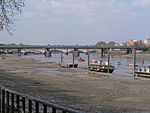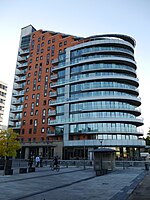Deodar Road

Deodar Road is a street in Putney, in the London Borough of Wandsworth. There are no other streets named Deodar Road in Great Britain. It was formerly the site of a mansion called The Cedars and a terrace of houses built in 1853. This was on the site of Copthall, a villa rebuilt in the 1620s. Next to this was a mansion, Putney House, built in the 1680s; it was converted into a College for Civil Engineers in 1839 and demolished in 1857. When the railway and bridge crossing the Thames was built (1887-9) by The London and South West Railway it more or less went straight through the terrace of houses. The area fell into decline and the Cedars was demolished about 1890. The road was named after The Cedars; the Himalayan cedar, Cedrus deodara. It was previously called Ranelagh Road. The odd numbered houses back on to the river.
Excerpt from the Wikipedia article Deodar Road (License: CC BY-SA 3.0, Authors, Images).Deodar Road
Deodar Road, London
Geographical coordinates (GPS) Address Nearby Places Show on map
Geographical coordinates (GPS)
| Latitude | Longitude |
|---|---|
| N 51.46401 ° | E -0.20977 ° |
Address
Deodar Road 50
SW15 2NN London (London Borough of Wandsworth)
England, United Kingdom
Open on Google Maps










